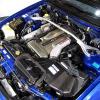How Do I Tell What My Spring Rates Are?
Announcements
-
Similar Content
-
Latest Posts
-
For sure the later RB26 variants had a different setup (6 cam voltage sender?), but the RB25DE/DET share the same ECU pinout/PCB footprint, and at the ECU plug it ends up being 'throttle sensor in' & 'throttle sensor out' (to A/T TCU) ...you stick a multimeter on these pins and you'll find them directly connected (0 ohms) ; I had an pair of Nissan ECUs on the bench long ago, and I noticed this throttle sensor in/out link, actually linked to an op-amp ...which was unpopulated on the NA board, but present on the T board and I went 'ah-ha!' in some moment of clarity... ...it wouldn't surprise me if they changed strategy here though (in the software and actual monitoring of this signal), because they did with other stuff (A/T signals).. and 0.45v as a trigger point makes sense, as that's what the external TCU units expect at idle ; kudos, thanks for that insight...I suppose it boils down to whether or not Consult can display real time data of that signal's voltage... ...in any event, it presents the same target...ie; rotate TPS unit to achieve 0.45v to suit both ECU&TCU, and where do you goto from there? Just disconnect TPSwitch connector and/or that plus TPSensor connector....or do you go for the throat and disconnect IACV solenoid and see if it still stalls? (probably throws a recoverable fault code and goes for default idle strategy?)...
-
By PotatoCake · Posted
I’m also conscious that e85 is slowly being phased out. Not all United’s have them anymore. Can’t take the risk of being low on petrol and assuming the servo will have it. -
MR HAMMER has said his piece. Painted up to avoid Rusty Rusty. Actually lines up well. (i.e it lines up the same as the unmolested GTR guard). Turns out the GTR Strut brace does foul on the bonnet vents ever so slightly. May need a little bendy bendy if intended to keep using with a strut brace. So spacing it out to clear the FAST102 is not an option. Annoyingly, the bonnet vents also foul on the heater lines running over the engine. Given this engine does not EVER require a heater, a delete loop is going to be used. Don't worry, the defogger uses the AC. The heater is basically "Do not use the aircon and turn the fan on". It will still be effective, I promise.... once I get the system regassed... Will have to revisit with unvented bonnet I suppose, and suitable strut brace. There's plans to do this and other things tonight and bleed brakes (there was a weep) and put the bumper back on, and take Good Friday morning - Because troubleshooting on the side of the road limping it home at midnight tonight is ... not very smart.
-
By GabsReDeal · Posted
Thank you all for you assistance. I contacted Nistune regarding the support for the RB20DE along with my ECU Code (23710-10U00). They do have a map for it and added the RB20DE as a purchasable option now as well. They also added Malta as a Billing and Delivery options as this was missing. I was honestly amazed at their quick response and action, it took less than 24 hours. I also looked again at direct fit options for injectors, just in case I were to replace them. DeatschWerks seem to use a Bosch EV14 base and makes ones that fit mine at 440cc lowest, but also have 550cc at the same price. I tried looking for other direct fit options and managed to find one (also Bosch EV14 based) which includes a plug and play adapter on ebay. Did a small test with a Noid Light on the troubled injectors and all seems good, so they are pulsing properly electrically. One weird part is that they are missing on the same two cylinders as before I got the injectors cleaned. Mechanic also found this weird as he did not label the injectors and it is unlikely to have the faulty injectors be installed in the same cylinders.
-









Recommended Posts
Create an account or sign in to comment
You need to be a member in order to leave a comment
Create an account
Sign up for a new account in our community. It's easy!
Register a new accountSign in
Already have an account? Sign in here.
Sign In Now